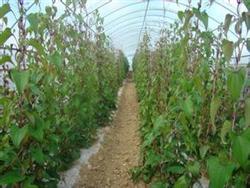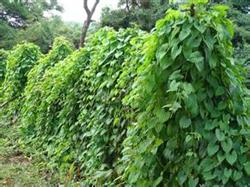Integrated Control techniques of Diseases and insect pests in Chinese Yam

1. Agricultural prevention and control. The selection of disease-resistant varieties is an effective method to control diseases and insect pests of yam. When cultivating disease-resistant varieties, the varieties should be rotated every 2 ~ 3 years, and attention should be paid to the purification and rejuvenation of the varieties. two。 Rotation can reduce or avoid the harm of stem rot and root-knot nematode of Chinese yam. Crops that are not infected, such as corn, wheat, radish, watermelon, etc., should be rotated at least once every 3 years with corn (2343), radish, watermelon and other crops. In the old areas where yam is cultivated all the year round, rotation of yam should be done once a year. Rotation of flood and drought can be carried out in areas with favorable conditions, and the control effect is better. 3. Soil preparation can directly eliminate pathogens overwintering in the soil. Selecting high dry, low humidity, fertile and loose sandy loam for soil preparation in autumn, the diseased remains left on the surface can be turned into the soil, accelerate the decomposition and decay of the diseased bodies, and lose the vitality of some pathogens after freezing in winter and drying in spring. 4. Fertilizing and irrigating yam are fertilizer-loving crops, and rotten organic fertilizer must be applied during soil preparation. Generally, the application of phosphorus and potassium fertilizer is beneficial to the formation of mechanical tissue of Chinese yam and enhance the ability of resistance to pathogenic bacteria. Excessive application of nitrogen fertilizer is easy to cause overgrowth of plants, tender stem and leaf tissue, and easy to get Chinese yam anthracnose. The principle of watering is "no drought, no watering". When watering, clean water sources must be watered thoroughly, there can be no stagnant water in the fields, and drainage should be carried out in time during the rainy season to avoid root rot. 5. The field is clean and the weeds in the field should be eliminated manually. The timely removal of the leaves and stems of the diseased yam can reduce the re-infection of pathogens. When the yam is harvested, the diseased remains, weeds and rotten stems left on the ground should be burned or taken out of the field for deep burial to reduce the overwintering pathogens. Second, chemical control 1. Chinese yam anthracnose harms stems and leaves, causing stem withering and falling leaves. Control method: soak the seed potato with 1 ∶ 1 ∶ 150pod solution for 10 minutes. Spray the first drug with 50% carbendazim 600 times solution when the seedlings are full, and spray the second time 10 days later. From July to August, it was found that 65% Dysen zinc wettable powder 500 times, 50% bacilli special wettable powder 800 times, 50% methyl topiramate 700 times 800 times, spray 2 times 4 times according to the severity of the disease, and spray alternately. Every time the interval is 8 to 10 days, the spray solution should be replenished after the rain. two。 Short-body nematode disease causes dwarfing of the plant, yellowing and withering of the whole plant in severe cases, and tuber damage with tubers of different sizes, affecting yield and quality. Control method: before sowing, treat the soil with 5% methamidophos granules 5 kg per mu mixed with 100 kg of moist fine soil, spread evenly on both sides of seed potatoes through trenching, or spread evenly in combination with soil preparation, and soak 25-30 cm into the soil. 3. Leaf wasps bite the leaves of Chinese yam, resulting in serious loss of leaves, affecting photosynthesis and reducing tuber yield. Use 2% dipterex to kill 3000 times of liquid or 1000 times of crystal trichlorfon to spray stems and leaves.
- Prev

The cultivation of digging holes in Chinese yam is not high-yield.
1. Plastic casing cultivation techniques 1. The plastic casing is processed with a hard plastic pipe with an inner diameter of 6 cm and 7 cm, cut with a saw, each section is 80 cm long and slit longitudinally, with a width of about 0.5 cm. Then cut obliquely to the port at one end of the tube 20 cm away from the port, and the port is semicircular after cutting. In the plastic pipe.
- Next

How to prevent diseases and insect pests of Chinese yam
First, anthrax. Chinese yam is easy to produce anthracnose in high temperature and rainy season, resulting in withered stems and fallen leaves. In the early stage, there were black spots on the leaves, but in the later stage, the color of the leaves changed to black, and the disease spots were flooded, which seriously affected the plant growth and reduced the yield. Prevention and treatment: spray 50% acetaminophen 600 times every 7 days, or 7.
Related
- Where is it suitable to grow horseradish in China? it is expected to see the middle altitude horseradish in Alishan.
- How to prevent tomato virus disease reasonably? (Control methods included)
- Many people like to plant towel gourd on the balcony. What are the main points of this method and management?
- What crops can chili peppers be mixed with?
- Fertilization techniques and matters needing attention in Tomato
- What are the grafting techniques for peach seedlings in spring?
- Harm and control methods of root swelling disease of Chinese cabbage
- What are the pests of sweet potatoes? How to prevent and cure it?
- Symptoms, causes and Control methods of navel Rot in Tomato
- The cause of "Cucumber rotten bibcock" in Farmers' planting Cucumber and its Control Plan

